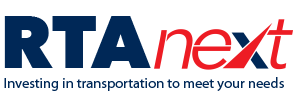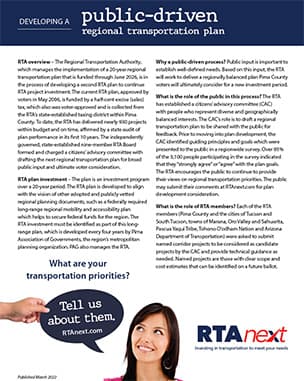
FAQs
The following information is available to address questions we often hear about the Regional Transportation Authority and the RTA Next process to develop a new 20-year regional transportation plan.
The Regional Transportation Authority, or RTA, is a state-established (August 2004) political subdivision which brings together various governmental entities within Pima County to identify and develop solutions that will address transportation needs on a regional basis. The RTA is governed by an independent board made up of local, county, state and tribal government representatives.
The RTA is authorized to develop a 20-year regional transportation plan and request voter approval of the plan and a dedicated RTA transaction privilege (sales) tax to fund it. The plan must include a transit component.
The RTA offers the region a flexible and reliable funding source which is dedicated to regional transportation priorities based on public input and feedback. A new RTA sales tax would generate more than $2.46 billion – in today’s dollars – over 20 years for continued regional transportation improvements.
The current Regional Transportation Authority plan and countywide half-cent sales tax end in June 2026. Annual average revenue collections total more than $110 million toward regional transportation improvements.
Although population growth levels in the greater Tucson region have declined since the 2008 Great Recession, the region continues to grow at an annual average rate of about 1%. To meet the demands of our region’s changing demographics and to expand or maintain a quality transportation system, another RTA-funded plan will help to address needed improvements over the next 20 years.
- The 2006 plan provided over 1,000 much-needed transportation enhancements across the region, including new and expanded transit services. Still, the aging transportation system needs ongoing improvements to meet current and future user demands.
- A regional approach to improving the transportation network benefits the region as a whole and not just one jurisdiction or another. The RTA collaborates with its member jurisdictions to find integrated transportation solutions to maximize efficiencies and save costs.
- A half-cent RTA sales tax will provide nearly two-thirds of the transportation funding annually for the region compared to combined federal and state funding sources available to the region.
- RTA sales tax: $100+ million (Source: ADOR/RTA)
- Federal funding to region: $22 million (Source: STBG*)
- State funding to region: $29 million (Source: HURF**)
*STBG – Surface Transportation Block Grant funding provides flexible funding that may be used by states and localities for projects to preserve and improve the conditions and performance on any federal-aid highway, bridge and tunnel projects on any public road, pedestrian and bicycle infrastructure, and transit capital projects, including intercity bus terminals.
**HURF – Highway User Revenue Fund, a per-gallon tax on gasoline and other fuel sales, collected statewide and distributed based on formulas set in state statutes to cities, towns, counties and state agencies
- Ongoing transportation improvements help meet the needs of a growing population
- 1,072,000 (current)
- 1,250,000 by 2050 (estimated)
Transportation needs in the greater Tucson region continue to be greater than the amount of transportation funding available.
Over the next 30 years, regional transportation funding needs are anticipated to total $32.4 billion. Recent transportation plans (Pima Association of Governments’ 2045 RMAP Update) show that projected transportation revenues (without continued RTA funding) available over the next 25 years within Pima County will total $12.8 billion. If the RTA plan and sales tax are approved, the tax is anticipated to generate an additional $2.46 billion over 20 years, and this represents a significant amount of money that can be applied toward reducing that funding gap. Even with the RTA sales tax contribution, the region faces a remaining funding shortfall of $17.14 billion.
| $32.4 billion | Overall regional transportation funding need through 2045 |
| $2.46 billion | New RTA Next plan and half-cent sales tax revenues over 20 years – anticipated RTA contribution, if voter approved |
| $12.8 billion | Available regional revenues from state and federal sources through 2045 – anticipated regional funding contribution through 2045 |
| $17.14 billion | Remaining revenue needed for regional transportation improvements – long-term funding gap through 2045 |
Currently, the RTA is the single largest contributor to regional transportation improvements with an annual average investment of more than $110 million. This compares to a total of about $51 million (FY 2023) annually from both state and federal transportation funding resources, which have remained virtually constant because federal and state fuel tax rates have remained unchanged since the early 1990s.
The current RTA sales tax expires in June 2026. For the benefit of the region, the RTA would like to have a new plan and half-cent sales tax initiatives in place for voter consideration prior to that time to allow for a seamless transition from one plan to the next to continue regional transportation improvements.
The Regional Transportation Authority will present two voter initiatives:
1) A 20-year regional transportation plan that defines major elements, project costs and corridor construction start schedules.
2) A half-cent sales tax to fund the plan. Both initiatives must pass for the plan to be implemented.
By law, the RTA sales tax must be spent as defined by a voter-approved regional transportation plan. If any future substantial changes are made to an approved plan or significant cost overruns occur, state law requires the RTA to bring changes back to the voters for consideration.
- Funding of routine maintenance of pavement (such as potholes) is ineligible for RTA sales tax funding, per RTA state statutes.
- Capital maintenance (reconstruction) can be included in the plan, which may include traffic signal modernization or reconstruction of pavement or other transportation infrastructure within RTA-funded corridors.
- Flood control work, beyond drainage improvement affecting a specific corridor project area, is not eligible for RTA funding. (Flood control projects are funded by a countywide property tax within the Regional Flood Control District.)
- In general, utility improvements are not eligible for reimbursement and are funded by the utility or jurisdiction.
- The RTA’s countywide, half-cent sales tax applies to retail items, contracting, utilities, food service, and rent on real and personal property.
- Groceries and pharmaceutical drug sales are exempt.
- The sales tax is collected in Pima County, which serves as the boundary for the RTA taxing district.
- Pima County residents and tourists/visitors alike will pay the tax no matter where they shop.
The cost for a single person per month would be $6.20 and per year $74.40. This is based on monthly cost of living expenses of $1,240 (minus rent) multiplied by .005 (Source: numbeo.com).
If a family of four spent $60 at a restaurant, for example, the RTA tax would be an additional 30 cents. Since the RTA would extend an existing sales tax, you should not notice a difference in retail costs if a tax extension initiative is approved by voters.
An increase in the state gas tax is not likely due to already high gas prices and the need for a two-thirds majority approval by the Arizona Legislature. A local gas tax is not an option because it is prohibited by the Arizona Constitution. Even if it were possible to increase the gas tax, gas taxes cannot be used for transit.
A sales tax option is the only one that has been given to Pima and Maricopa counties from the state Legislature to resolve urban transportation problems. Pima County does not have a transportation sales tax, though, and is the only county in the state that does not have one.
To ensure that everyone can access and use reliable transportation in the region, the RTA’s development process for the next 20-year plan started with RTA partner jurisdictions submitting their recommended projects for plan consideration. RTA members include Pima County, the Cities of South Tucson and Tucson, Towns of Marana, Oro Valley and Sahuarita, Pascua Yaqui Tribe, Tohono O’odham Nation and Arizona Department of Transportation.
- Jurisdictions submitted projects that address each community’s needs.
- Reviews of each roadway corridor project were done to determine how they fit into the larger transportation network to improve overall connectivity and mobility in the region.
- Plan projects are spread across the region and transcend jurisdictional boundaries to benefit transportation users regionwide.
- An improved regional transportation network benefits transportation users in many ways:
- Increased mobility and connectivity
- Better roads that move traffic more efficiently across the region
- A variety of transit options from which to choose
- More alternative transportation choices such as new bike lanes, sidewalks, greenways which support cleaner air
- Safety
- Additional pedestrian and cyclist amenities will make streets safer
- Modernized intersections improve safety for all users
- Signalized pedestrian/bike crossings and bus pullouts
- Getting people to work safely and efficiently also helps promote employment opportunities for existing and future populations
- Economic opportunity
- Much of the planning and construction will be completed by local companies, which allows the money spent on improvements to stay in the community and create or maintain jobs
- Communities will benefit from a better transportation system, which helps attract new residential and commercial investment, such as business expansions and relocations, creating new jobs and income
- Increased mobility and connectivity
Comment
Still have a question? Please contact us at info@rtanext.com or submit a comment online.

